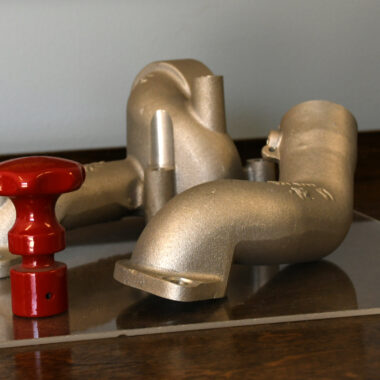Development Released: Progressing Casting Aluminum Illinois
Development Released: Progressing Casting Aluminum Illinois
Blog Article
Precision and Excellence: Ideal Practices for Successful Light Weight Aluminum Casting
In the world of light weight aluminum spreading, attaining accuracy and excellence is not simply a goal however a requirement that differentiates quality. The meticulous procedure of light weight aluminum spreading needs interest to detail at every stage, from material option to last completing touches.
Product Option
When considering product option for aluminum casting processes, durability, and heat resistance are extremely important variables to assess. Aluminum alloys offer a large range of choices, each with unique residential or commercial properties that can significantly influence the high quality and performance of the last casted product. One usual option is the 356 alloy, known for its superb fluidity and resistance to deterioration, making it appropriate for a variety of applications. For high-stress settings requiring premium stamina, the 7075 alloy stands out as a result of its high strength-to-weight ratio. In addition, the 6061 alloy is favored for its great weldability and formability, making it a versatile choice for intricate styles.
In the selection process, it is vital to take into consideration not just the mechanical residential or commercial properties of the alloy however likewise its thermal attributes. Warmth resistance is important to guarantee that the casted part can endure the temperatures it will be subjected to during operation without jeopardizing its structural stability. By thoroughly examining the toughness and warm resistance of various aluminum alloys, producers can make educated decisions that result in top quality, reputable casted products.
Mold Design
In the world of light weight aluminum casting finest techniques, an indispensable facet that substantially affects the end product's top quality and honesty is the careful style of the mold. Mold and mildew layout plays a vital function in identifying the dimensional accuracy, surface area finish, and overall details of the actors aluminum component. When producing a mold for light weight aluminum spreading, several key variables need to be considered to make certain ideal results.
To start with, the mold design must represent the product flow characteristics of liquified aluminum to avoid flaws such as shrinkage, porosity, or misruns. Correct gating and riser placement are crucial aspects in the mold and mildew style procedure to help with smooth steel flow and decrease the formation of air pockets.
In addition, the mold layout ought to take into account the air conditioning price of the aluminum to protect against breaking or distortion throughout solidification. Adequate airing vent and cooling down channels within the mold and mildew can aid regulate the temperature level circulation and promote consistent solidification of the steel.
Process Optimization
To boost performance and quality in aluminum casting, process optimization plays a pivotal duty in making best use of and streamlining operations output. By fine-tuning each action of the spreading procedure, makers can determine bottlenecks, reduce waste, and enhance total performance.
In addition, applying lean production principles can even more enhance procedure optimization in light weight aluminum casting. By focusing and eliminating non-value-added tasks on continual enhancement, producers can achieve greater effectiveness levels and far better resource usage. In addition, normal tracking and analysis of crucial performance indications (KPIs) assist in identifying locations for enhancement and making data-driven decisions to maximize the casting procedure continuously.
Quality Control
Refine optimization in aluminum spreading not only boosts effectiveness and productivity yet also lays the foundation for rigid quality control actions to support sector requirements. Quality assurance is critical in ensuring that final light weight look what i found aluminum castings fulfill the required requirements and performance requirements. Implementing a detailed quality assurance process entails various steps, starting from the first design stage via to the final assessment of the cast parts.

Additionally, establishing clear quality assurance methods and paperwork procedures is important for monitoring and keeping an eye on the casting procedure. By preserving thorough records of manufacturing parameters, screening results, and examination reports, suppliers can guarantee consistency and traceability in their light weight aluminum casting procedures. Abiding by rigorous top quality control practices not just enhances the general reliability of light weight aluminum spreadings but additionally instills self-confidence in consumers relating to the top quality of the end products.
Ending Up Techniques
How can aluminum casting be enhanced through precise application of completing methods? Completing methods play a critical duty in boosting the top quality and aesthetics of aluminum spreadings.

In addition, techniques like powder finish or painting can be put on light weight aluminum look what i found spreadings to offer both visual allure and additional security versus environmental elements. By meticulously selecting and using the ideal finishing methods, suppliers can ensure that their aluminum castings satisfy the highest possible standards of high quality and performance.
Verdict
Finally, successful aluminum casting needs accuracy and excellence in product option, mold and mildew design, process optimization, quality control, and completing methods. By complying with ideal techniques in each of these locations, suppliers can ensure premium and constant lead to their light weight aluminum casting procedures. casting aluminum illinois. It is important to take notice of every information and continually make every effort for renovation to attain optimum end results in light weight aluminum casting
The precise process of aluminum casting needs focus to information at every stage, from material selection to final ending up touches.To boost effectiveness and high quality in aluminum casting, procedure optimization plays a crucial function in enhancing operations and making the most of result.Process optimization in aluminum spreading not just enhances efficiency and performance however also lays the structure for rigid quality control measures to promote market standards.One critical element of quality control in light weight aluminum casting is the usage of sophisticated testing strategies to evaluate the integrity and buildings of the castings.In conclusion, successful aluminum casting requires precision and excellence in material choice, mold style, process optimization, top quality control, and ending up methods.
Report this page